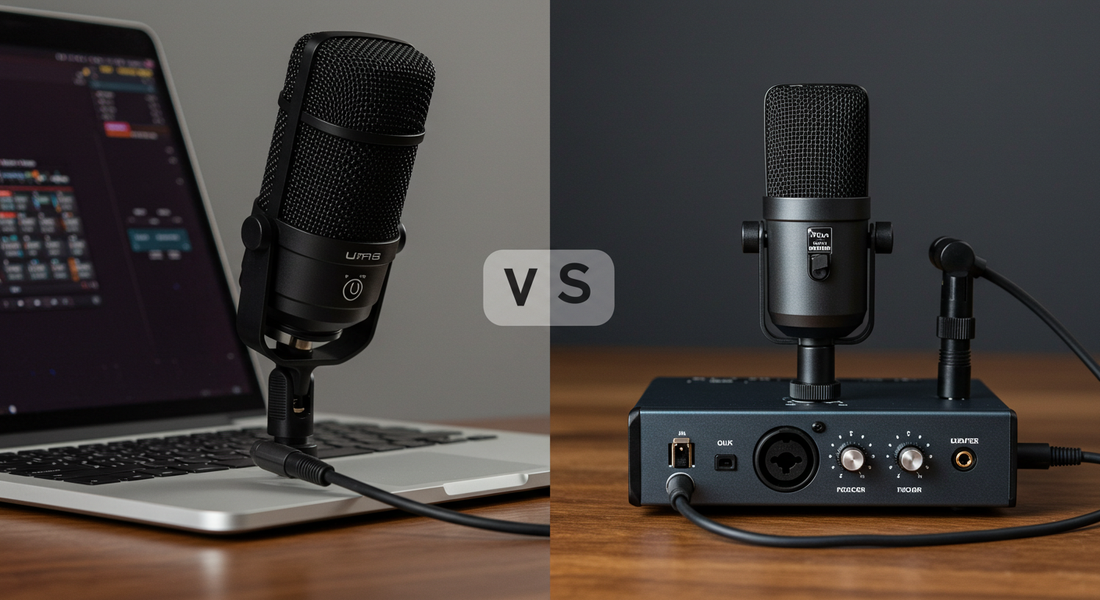
The Great Mic Debate: Should Beginners Start with USB or XLR?
Share

Whether you're starting a podcast, streaming your gameplay, or recording your first YouTube video, one thing is certain: audio is king. You can have the best camera and the most engaging content, but if your audio is crackly, distant, or full of background noise, your audience will tune out.
Unlocking crystal clear audio is the first step to a professional setup. But as a beginner, you're immediately faced with a major decision: should you start with a simple USB microphone or invest in a more complex XLR setup? This guide will break down the great USB vs XLR mic debate.
Team USB: The Pros & Cons of Plug-and-Play
A USB microphone is an all-in-one solution. It has a built-in analog-to-digital converter, meaning you just plug it directly into your computer's USB port, and it's ready to go.
-
Pros:
-
Simplicity: This is the biggest advantage. There's no extra equipment required. You plug it in, select it as your audio source, and start recording. It's the definition of "plug-and-play."
-
Cost-Effective: Because you don't need to buy any extra gear, a high-quality USB mic is often much cheaper than a full XLR setup, making it the perfect choice for a beginner podcast setup on a budget.
-
Portability: With just a single cable, a USB mic is incredibly easy to pack up and take with you.
-
-
Cons:
-
Limited Upgradability: A USB mic is a closed system. You can't upgrade individual parts. If you want better quality, you have to buy a whole new microphone.
-
One Mic Per Computer: It's very difficult to use more than one USB microphone on the same computer at the same time, which is a major limitation for podcasts with multiple in-person hosts.
-
Team XLR: The Pros & Cons of Professional Grade Audio
An XLR microphone is the industry standard for professional recording. It's an analog microphone that connects to your computer via a three-pin XLR cable and a separate piece of hardware.
-
Pros:
-
Superior Sound Quality: While high-end USB mics sound great, the ceiling for audio quality is much higher in the XLR world. The components are more specialized and of a higher grade.
-
Ultimate Flexibility: An XLR setup is modular. You can mix and match any XLR mic with any audio interface. You can upgrade your mic, your interface, or your cables independently as your skills and budget grow.
-
Multi-Mic Setups: XLR setups are built for expandability. Even a basic audio interface will allow you to record with two microphones at once, and more advanced models can handle many more.
-
-
Cons:
-
Requires More Gear: An XLR mic cannot plug directly into your computer. It requires an audio interface.
-
Higher Initial Cost: The combined cost of an entry-level XLR mic and an audio interface is almost always higher than a comparable USB mic.
-
What is an Audio Interface and Do You Need One?
If you choose the XLR path, you will need an audio interface. Think of it as an external sound card that acts as a bridge between your analog microphone and your digital computer.
-
What it does: The audio interface guide is simple:
-
It converts the analog signal from your microphone into a digital signal your computer can understand.
-
It supplies the necessary power (called "phantom power") that many XLR microphones need to operate.
-
It gives you physical knobs to control the volume and gain of your microphone.
-
You only need an audio interface if you are using an XLR microphone.
The Verdict: Which Path is Right for You?
The right choice depends entirely on your goals, budget, and commitment.
-
Choose USB if: You are a solo creator, a streamer, or a podcaster on a budget. You value simplicity and want the best possible "plug-and-play" experience without a steep learning curve.
-
Choose XLR if: You are serious about audio quality from the start. You plan to have co-hosts in the same room, or you want a system you can upgrade and expand over time without having to start from scratch.
Our Top Mic Recommendations
-
The Best USB for Beginners (The 'Podcaster Pro'): Our top pick for the best streaming microphone in the USB category. It offers crystal-clear audio, a built-in headphone jack for zero-latency monitoring, and a simple plug-and-play setup that will have you sounding professional in minutes.
-
The Best XLR Starter Kit (The 'Creator Studio Bundle'): This bundle is the perfect entry into the world of professional audio. It includes our highly-acclaimed XLR condenser microphone, a beginner-friendly 2-channel audio interface, and all the necessary cables to get you started on the right foot.
